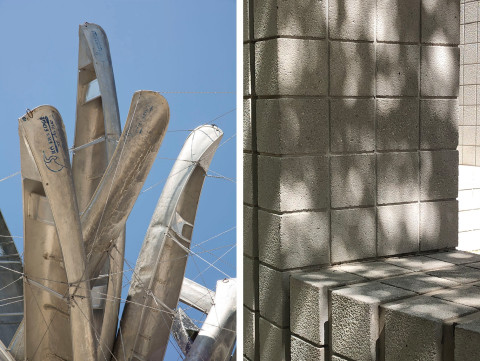
Larry Speck has spent nearly fifty years problem-solving, teaching, and advancing the study of architecture at The University of Texas at Austin. A staple of UT’s School of Architecture, Speck teaches more than a thousand students each year, including 100 incoming freshmen in the undergraduate studies class Creative Problem Solving, and 900 students in Architecture and Society. With more than eighteen teaching assistants alone for Architecture and Society, the class according to Speck, runs “like a big machine.”
Both courses address issues that arise in the built environment such as problem solving and material considerations. For Speck, Landmarks’ collection provides real-world case studies that are easier to define and resolve when compared to large-scale building projects, which accounts for every range of issue.
“I talk about the fact that sometimes problems are given to us, and we need to figure out a solution,” said Speck, “But sometimes we make our own problems; we define an area of investigation or exploration. The solution need not be that we terminated it, but more like, how do you explore that and find a kind of solution?”
Speck cites artist James Turrell as an example of this in Creative Problem Solving, as he sees Turrell as someone who has centered his life’s work on solving a problem of their own creation.
“In the class, I talk about James Turrell and how he gave himself the problem of light,” said Speck. “He's an artist, he chose the problem he wanted to solve over his whole career, and it had to do with light. And so, we talk about a lot of different things he did.”
Paramount to this discussion on Turrell is a visit to the artist’s Skyspace commissioned by Landmarks, The Color Inside. Students venture to the rooftop of the William C. Powers, Jr. Student Activity Center to discuss Turrell’s employment of light in the Skyspace and the ways in which he’s made a career of channeling it. Turrell also serves as an example for Speck’s Architecture and Society, where they explore the Skyspace as an architectural structure that’s “enlivened” by light.
Other works from Landmarks’ collection make an appearance in this class, including Nancy Rubin’s Monochrome for Austin and Sol LeWitt’s Circle with Towers. Speck uses these works in direct contrast to each another, noting the inherent strengths and weaknesses of the materials used, pointing out why some things are made of steel or concrete and others not.
“I want to talk about forces of tension and compression, about how those are defined and how they’re calculated,” said Speck. “What materials resist tension? What materials resist compression? And how do you size those elements to resist the amount of forces applied?”
Speck explains the tension/compression dichotomy in this way:
“We have a beautiful compressive structure in the Sol LeWitt piece. You can just feel all those concrete blocks and all of those forces, all of the weight moving by gravity through that piece. It's a very tectonic piece. It's all about understanding compression, understanding what materials resist compression and how those materials size themselves.”
Monochrome for Austin on the other hand operates in the opposite way:
“The Nancy Rubins piece is all about tension and it's got all the cables and wires made of steel, a material good in tension. Concrete blocks are crap in tension. So we can use a very small amount of material because it's super strong and it resists all the cantilever forces caused by hanging canoes out over Speedway. And so the students can really see the difference between compression and tension.”
The juxtaposition of Monochrome for Austin and Circle with Towers presents the tension/compression lesson in a tangible way, allowing students to quickly uncover material considerations they potentially had seen but never questioned or understood.
“Those two works are great for these examples. They're almost like little instructional lessons, very specific and particular,” said Speck. “These same things might be happening in a building, but they’re hidden in the midst of a thousand other things. The Landmarks works are so didactic; they're focused examples.”
These activations of the collection make students aware of the material world around them and push them to question other elements of the built environment.
“Students will come to me and say they hate the Perry-Castañeda Library (PCL). They hate it until I have them do a solar analysis and to see how it works in terms of the sun and how different sides of the building have different orientations, and how the sun shading works. They start to see that the building is like a precise machine that is there to reduce heat gain on the building, and save energy, it’s ecologically sound and sustainable. That opens their eyes to see that it's not just about, ‘I like it’ or ‘I don't like it,’ they have to understand it.”
For many of Professor Speck’s students, his assignments are their first interaction with the collection. Landmarks’ projects illuminate the concerns of the material world in small chunks, revealing different aspects to each person that engages with them.
Learning with Landmarks is a dedicated blog series highlighting the unique and innovative ways that students, faculty, and other scholars use the collection.
